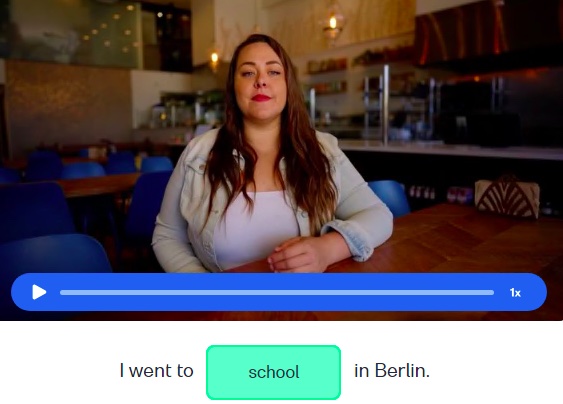Direct and Indirect Speech: The Ultimate Guide
Learn how and when to use direct and indirect speech with this guide.
I want to learn...
When you need to report what other people have said in English, you’ll need to use direct and indirect speech. This might seem difficult at first. But once you’ve learned how to use direct and indirect reported speech, you’ll be able to report and quote what others have said with ease.
Read on to learn all about direct and indirect speech and how to use them correctly.
What are direct and indirect speech?
Direct and indirect reported speech refer to how you quote or report what someone else has said. They have a similar function in both speaking and writing, but their grammar is very different. We’ll get into the differences between them in the following sections.
When to use direct speech
Use direct reported speech when you want to quote the exact words someone has said. Let’s imagine your friend said, “I learned a lot of English using the Busuu app.” To quote your friend directly you would say or write the following sentence:
My friend said, “I learned a lot of English using the Busuu app.”
You can see that nothing changes. You repeat the words you want to report and that’s it. When you use direct speech, you bring the original speaker’s exact words into your speaking or — more commonly — your writing.
When to use indirect speech
Use indirect reported speech to report what someone else has said without necessarily using the same words. You keep the original speaker’s meaning and intent but can rephrase their sentences. When you use indirect speech, you often have to change the tense, pronouns, and time references.
Let’s look at the previous example again. In indirect speech, “I learned a lot of English using the Busuu app” can become:
My friend said she learned a lot of English using the Busuu app.
This is the simplest way to make indirect speech. Notice the change to the pronoun — the word ‘I’ from the original sentence changes to ‘she’ in the reported sentence. This keeps the meaning and intent the same and only slightly changes the words. You can be more flexible though — take a look at the next sentence:
My friend said she loves the Busuu English app.
Here the meaning and intent are the same. But the words are different. When using indirect speech, paraphrasing is fine, just as long as you keep the original meaning.
Indirect speech is a big part of everyday communication — much more so than direct speech. Although it’s a little more complicated, it’s also more useful.
How to use direct speech
Direct speech isn’t common in spoken English, but it’s totally fine to use it when speaking. It’s easy too. You don’t need to change anything or do anything when you speak. Writing is a different story though.
Here are some key rules and tips to help you use direct speech in your writing:
Quotation marks
Always use quotation marks around the words you quote. See example below:
My friend said, “I am learning Spanish.”
Reporting clause
You can put the reporting clause (‘he said,’ ‘she asked,’ and so on) either before or after the quoted speech. See examples below:
“I’m going to the store,” she said.
Or
She said, “I’m going to the store.”
Punctuation
Make sure commas, periods, question marks or exclamation marks at the end of the quoted speech are inside the quotation marks. See example below:
“Did you finish your homework?” asked John.
Capitalization
Give the first word in the quotation marks a capital letter. See example below:
He asked, “Are we meeting at 3pm?”
Changing Speakers
Use a new line or paragraph when the speaker changes. See example below:
“I can’t wait for the weekend,” said Alex.
“Me neither,” replied Mia.
How to use indirect speech
When you use indirect (or reported) speech, you need to make more changes to the original sentence. This is true whether you’re speaking or writing. Here are some important rules for you to remember:
Quotation marks
You don’t need to use quotation marks when you make an indirect speech sentence. So, “I’m going to the gym” becomes:
He said he was going to the gym.
Verb tense
Usually — but not always — when you use indirect speech you need to take a step back with the verb tense. So present tense verbs in the original sentence become past tense verbs in indirect speech. Here are a bunch of examples showing you how this works.
Examples of indirect speech
| Original sentence | Indirect speech |
|---|---|
| "I play sports on the weekend.” | She said she played sports on the weekend. |
| “I’m writing a novel.” | Jim said he was writing a novel. |
| “Maya left on Saturday.” | He said Maya had left on Saturday. |
| “I have seen that movie 10 times.” | He said he had seen that movie 10 times. |
| “We were visiting relatives at that time.” | She said they had been visiting relatives at that time. |
| “I will see you next week.” | He said he would see me next week. |
| “Chris will be moving next Monday.” | She said Chris would be moving next Monday. |
Like many things in English, there are exceptions to this:
1) If something is still true or always true, you don’t need to change the tense. So the sentence, “The sun is big and round,” becomes:
He said the sun is big and round.
2) If you use a present tense reporting verb, don’t change the verb tense. “August is the best time of year to visit” becomes:
She says August is the best time of year to visit.
3) Past perfect tenses stay the same. So “I had left the house before Mum got up” becomes:
She said she had left the house before her mum got up.
Pronouns
Change the pronouns so the meaning stays the same. For example, “I love this app” becomes:
She said she loved the app.
(Or use ‘he’ for a male speaker.)
Time and place references
Make sure the time and place references still mean the same thing too. If someone says ‘next week’ one week ago, you need to change it to ‘this week,’ for example. Or if someone says ‘here,’ you might need to change it to a place name or the word ‘there’ so the meaning stays the same.
Everything needs to match the context of when you’re reporting their words. This is tricky, so let’s look at an example sentence: “I’ll meet you outside the school tomorrow.”
If it’s now one day later and you’re outside the school, the indirect speech sentence becomes:
He said he would meet me here today.
Questions
Change the word order of questions to look like a normal (non-question) sentence. For example, “Where are you going?” becomes:
They asked where I was going.
Reporting verbs
Choose the right reporting verb to match the tone of the original speaker. Reporting verbs are a huge part of indirect speech. You can use them to show the attitude or emotion of either yourself or the original speaker.
Let’s look at some of the most useful reporting verbs and whether they’re common in casual or formal language. (I’ve listed them in the past tense because that’s usually how they’ll appear in indirect speech, but of course they can be present tense too.)
Statements
| Reporting verb | Tone or meaning |
|---|---|
| Said | Neutral (the most common reporting verb) |
| Told | Neutral – shows the speaker was sharing information |
| Stated | Formal or official |
| Declared | Formal – shows the authority of the speaker |
| Mentioned | Neutral – shows the speaker didn’t go into great detail |
| Went | Slang or colloquial way of saying ‘said’ |
Questions
| Reporting verb | Tone or meaning |
|---|---|
| Asked | Neutral (the most common verb for questions) |
| Inquired | Formal or official |
| Queried | Formal or official |
Commands and requests
| Reporting verb | Tone or meaning |
|---|---|
| Told | Casual – indicates a command |
| Ordered | Neutral – indicates a strong command |
| Requested | Neutral – more polite than ‘ordered’ |
Suggestions
| Reporting verb | Tone or meaning |
|---|---|
| Suggested | Neutral – sharing an idea or plan |
| Proposed | A formal version of ‘suggested’ |
| Recommended | Neutral – indicates advice |
| Advised | Neutral – indicates advice |
| Urged | Neutral – indicates strong advice |
Pro tip: When you’re speaking, stick to ‘said,’ ‘told,’ and ‘asked’ — they’ll get you a long way. If you need to write official or formal documents, look at some of the other words.
Direct and indirect speech for effective communication
To sum up, you need to know how to use direct and indirect speech to become fluent in English. For most people though — unless you do creative writing — indirect speech is the most common. Just remember that you often need to change the verb tense, and that you’ll need to make sure everything makes sense in the new context by using the right pronouns, time and place references, and so on.
If you follow the tips in this guide, you’ll be using direct and indirect speech like a pro in no time!
Master English with Busuu
With Busuu, you're just a few swipes away from interacting with millions of Native English speakers. Join our community, complete free English courses and develop your English skills, all on your mobile device.

